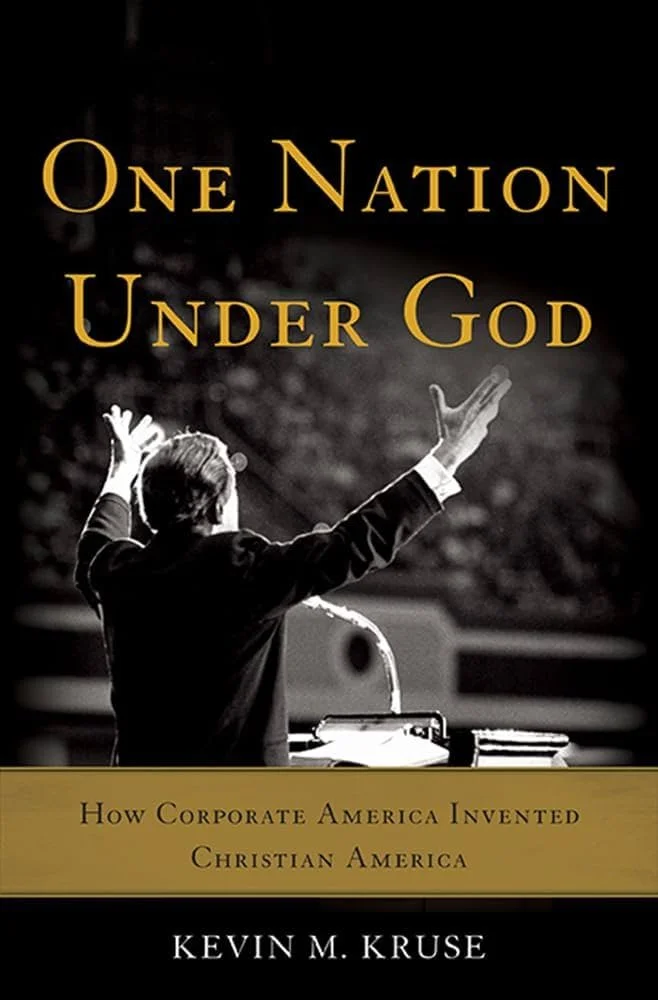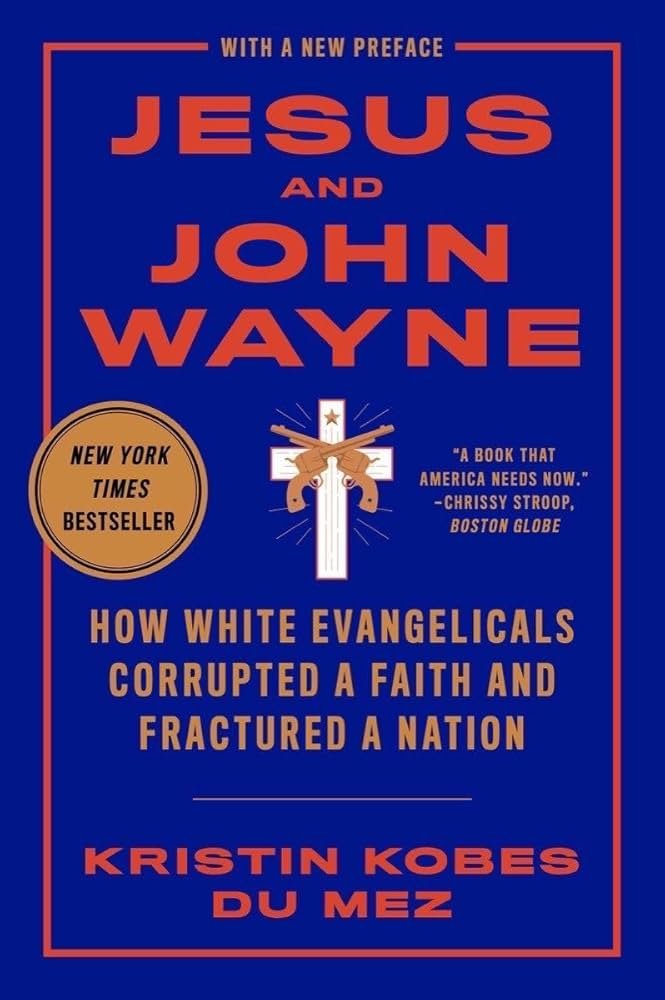In the Spiritual-Industrial
Complex We Trust
In his farewell address, President Dwight David Eisenhower famously warned of the dangerous rise of a “military-industrial complex” that tied the imperatives of industrial expansion and societal affluence to the buildup of military power, with the "unwarranted influence” that would accrue to the complex as it became increasingly foundational to American prosperity and power.[1]
Eisenhower didn’t invent the term or the concept; C. Wright Mills had raised the issue in The Power Elite in 1956, and FHA economist Winfield Riefler had introduced the term more than 12 years earlier in a Foreign Affairs article titled “Our Economic Contribution to Victory.”[2] The issue traced back to the ramp-up of Franklin Roosevelt’s “arsenal of democracy,” which awarded the vast majority of military contracts to major manufacturers at the same time it put Americans back to work. Eisenhower’s speech acknowledged his own administration’s culpability in the problem by referencing the size of its spending on “military security”: “We annually spend on military security more than the net income of all United States corporations.”[3]
Eisenhower was less candid—or at least less concerned or contrite—about the ascendancy during his presidency of what Jonathan P. Herzog termed the “Spiritual-Industrial Complex”: a de facto state religion that penetrated broad swaths of American life during Eisenhower’s tenure. This phenomenon stretched from Congress to courtrooms to classrooms to cinemas and currency fueled by the twin notions that faith and free market capitalism were the bulwarks of American resistance to the communist threats from without and within at the peak of the Cold War.[4]
In One Nation Under God: How Corporate America Invented Christian America, Kevin M. Kruse plumbs the ways the corporate leaders who exercised such an outsized personal and professional influence on Eisenhower in his post-military career aligned with presidential pastor Billy Graham to bankroll and evangelize the “Spiritual Mobilization” crusade. “Corporate leaders increased their commitment to Spiritual Mobilization,” Kruse writes, “because they believed there was a fast-expanding threat that endangered the nation.”[5] It was no less important that, for corporate America and Eisenhower’s Republican Party, marrying religion, politics, and patriotism just made good business sense.
Kruse demonstrates how a non-specific but fundamentally Protestant religiosity exploited Cold War fears and was foisted on the nation from the top: from the president, from Congress, and from some of the same titans of industry, like Milwaukee’s Harry Lynde Bradley and Californian millionaire Patrick J. Frawley, who were at the same time covertly underwriting the growth of the far-right John Birch Society.
What is particularly fascinating about how the business-church-state alliance took shape was its historical (and mock-historical) underpinnings. First and foremost, as Kruse explains, it was the kind of assault on Roosevelt’s New Deal that Eisenhower knew he couldn’t make frontally, by attacking specific, still-popular programs like Social Security. But he could still find ways to chip away at the New Deal’s ideological flank.
The Spiritual-Industrial Complex and the Spiritual Mobilization Campaign that built it also had much deeper historical revisionist ambitions. For nearly 100 years, would-be Christian Nationalists had tried and failed to advance a constitutional amendment saying that the government’s power came from God, as opposed to the consent of the governed. In the Eisenhower era, spiritual mobilization proponents found a way to relinquish their quixotic amendment quest and still achieve its overriding goal of demonstrating that the United States had been founded on faith and deeply held religious principles by insinuating the idea into the public sphere. They did so through organized prayer in congressional proceedings and cabinet meetings, adding “under God” to the pledge of allegiance, and universalizing the hitherto scattered presence of “In God We Trust” on U.S. currency.
Part of the purpose of this universalizing “In God We Trust” campaign and the insertion of “under God” into the Pledge of Allegiance was to subtly decouple these religious impositions from their partisan Protestant and Christian libertarian origins and embed them invisibly and indelibly into the American creed. “Although its creation depended a great deal on the groundwork of the Christian libertarian movement,” Kruse writes, “the new pledge moved well beyond that original base of conservative Protestants to unite Americans from across the religious and political spectrum.”[6]
Kruse argues that replacing “E Pluribus Unum” (“out of many, one”) with “In God We Trust” as the national motto had more profound implications for homogenizing the nation under Christian auspices. “In little more than two years’ time, ‘In God We Trust’ had surged to public notice, first taking a place of prominence on stamps and currency, and then edging its way past ‘E Pluribus Unum’ to become the nation’s first official motto,” he writes. “The concept of unity from diversity could not compete with that of unity from divinity.”[7]
It was easy enough to marginalize objections that stamping God’s name on money might in fact “debase God,” given that the deity's invisible hands were too fundamental to guiding the venerated free market to be sullied by adorning money.
Kruse also makes a convincing case that the country was more susceptible to such Christianizing co-optation during the Red-hunting McCarthy era than at other times simply because potential voices of opposition like the ACLU were too busy with freedom of speech and freedom of association and other threats to basic civil liberties to “devote any sustained attention to matters of church and state.”[8] Or they were simply backed into a corner by the equation of irreligiosity with communism and anti-Americanism to challenge the changes the Spiritual Mobilization campaign was imposing on American life. In any event, as Kruse writes, it was easy enough in that social and political climate to convince Americans that “the First Amendment mandated the separation of church and state, not the separation of religion and politics.”[9]
The incursions of these largely non-sectarian religious notions into government and national life shared critical funding sources with the likes of the John Birch Society, and the preachers promoting them practiced much more evangelical Christianity when they weren’t praying with presidents and other pols. As a result, at the same time they were arguably cracking open a back door to religious concepts that were much more specific.
In their 2023 essay “Televangelism and the Transformation of American Christianity,” historians Randi Barnes-Cox and Charity Rakestraw explore how the veiled Cold War millenarianism of the preachers who were pushing these ideas on radio and TV, as well as Billy Graham’s own beliefs, lurked just beneath the surface of the comparatively bland and innocuous religion they were helping to entrench in public life. In some respects, Barnes-Cox and Rakestraw argue, millenarianism was a particularly easy sell in the atomic era, when “apocalyptic themes” raised in sermons and popular radio broadcasts had “morphed into a globalized nuclear narrative, with televangelists engaging in end times prophesies based on Cold War developments and foreign activities.”[10]
The fact that these preachers were pointing toward an End Times nuclear showdown in their day jobs appeared nowhere in the discourse of vague national religion that was seeping into government and public life at the time via performative prayer and national mottos. But they also understood that if they could institutionalize the idea that the government’s power comes not from the governed but from God, the consent of the governed on specific government policies and actions might henceforth cease to matter.
Kristin Kobes Du Mez’s 2020 book Jesus and John Wayne reads like a dystopian sequel to One Nation Under God. It reveals how embracing a presidential pastor and the vague, non-denominational “In God We Trust” faith he preached in Washington opened the door to a new-look savior recast as an unholy hybrid of the corporate conman of Bruce Barton’s The Man Nobody Knows and a macho, avenging warrior modeled on John Wayne and John Rambo. This vision of “muscular Christianity” has arguably reached fruition in the ascendancy of Donald Trump as a Bible-hawking strongman and a football stadium state funeral for a Christian Nationalist podcaster bully in Conservative Movement godfather Barry Goldwater’s hometown.
As Du Mez writes, “Having replaced the Jesus of the Gospels with a vengeful warrior Christ, it’s no wonder many came to think of Trump in the same way. In 2016, many observers were stunned at evangelicals’ apparent betrayal of their own values. In reality, evangelicals did not cast their vote despite their beliefs, but because of them.”[11]
It should come as no great surprise to readers of One Nation Under God and Jesus and John Wayne how easily the Christianization of the national spirit—endorsed in the 1950s by the same president who lamented the rise of the military-industrial complex after signing eight consecutive budgets that funded it—gave way to a Christian nationalist autocracy and a reborn Department of War, or how the Spiritual-Industrial Complex ultimately begat a “God, Guns, and Trump” Spiritual-Industrial authoritarian regime.
[1] “The Military-Industrial Complex Speech,” Dwight Eisenhower, 1961. Document Excerpt.. https://constitutioncenter.org/the-constitution/historic-document-library/detail/the-military-industrial-complex-speech-1961
[2] Riefler, Winfield, “Our Economic Contribution to Victory,” Foreign Affairs, October 1, 1947. https://www.foreignaffairs.com/articles/united-states/1947-10-01/our-economic-contribution-victory
[3] Eisenhower, “The Military-Industrial Complex Speech.”.
[4] Herzog, Jonathan P., The Spiritual-Industrial Complex: America’s Religious Battle Against Communism in the Early Cold War, Oxford University Press, 2011.
[5] Kruse, Kevin M., One Nation Under God: How Corporate America Invented Christian America, Basic Books, 2015, p. 22.
[6] Kruse, p. 111.
[7] Kruse, p. 124.
[8] Kruse, p. 122.
[9] Kruse, p. 99.
[10] Barnes-Cox, Randi and Rakestraw, Charity, “Televangelism and the Transformation of American Christianity,” in Red Reckoning: The Cold War and the Transformation of American Life, LSU Press, 2023, p. 245.
[11] Kobes Du Mez, Kristin, Jesus and John Wayne: How White Evangelicals Corrupted a Faith and Fractured a Nation, Liveright, 2020, p. 3.

